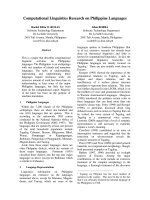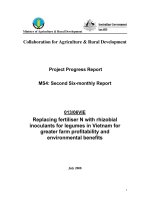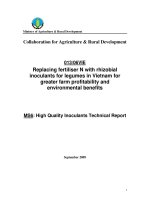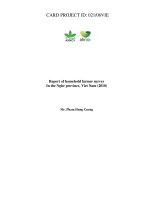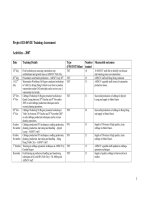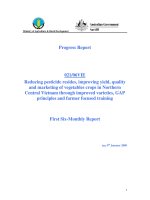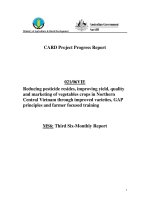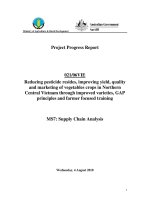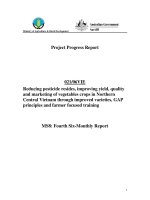Báo cáo khoa học nông nghiệp " RESEARCH ON WATER REUSE TECHNOLOGY FROM HATCHERIES FOR FOR SUSTAINABLE DEVELOPMENT AND ENVIRONMENTAL POLLUTION CONTROL " pdf
Bạn đang xem bản rút gọn của tài liệu. Xem và tải ngay bản đầy đủ của tài liệu tại đây (168.26 KB, 7 trang )
1
RESEARCH ON WATER REUSE TECHNOLOGY FROM
HATCHERIES FOR FOR SUSTAINABLE DEVELOPMENT AND
ENVIRONMENTAL POLLUTION CONTROL
Le Van Cat, Pham Thi Hong Duc, Le Ngoc Loc
Institute of Chemistry. Vietnamese Academy for Science and Technology
E –mail:
1. State of the art and practical requirements
To supply seeds for aquaculture, about five thousands existing hatcheries
produce annually 20 billion shrimp varieties and some billions other species (crab,
fish, mollusks, eel, crustacean) for grow - out production systems. Most
hatcheries use saline water for production and therefore are situated near the
seashore.
In applying conventional production schema “tank cultivation- open flow
system” a huge quantity of wastewater originating from water exchange is
discharged into the coastal environment. Wastewaters from hatcheries containing
uneaten feed, faces, excreta, pathogens, antibiotics could damage land, receiving
water bodies and habitats. Deterioration in water quality, habitat destruction, loss
of biodiversity, soil salination, disease transmission, antibiotic resistant
microorganisms, in some case, cause of algae bloom. [1, 4, 6, 7, 9] may also
occur.
For environmental protection in general and for the sustainable
development of aquaculture production specifically, the treatment of wastewater
or reuse of wastewater is therefore important. In addition, wastewater reuse brings
economic benefits for hatcheries far from saline water resources and shops trading
in fresh marine products due to reduction in the costs of transporting saline water
to these hatcheries.
Wastewater reuse is common in several countries [13, 14], but the
production schema has not been widely applied in Vietnam.
2. Pollution characteristics and wastewater treatment technologies
Wastewater from hatcheries or in general from aquaculture production is
not heavily polluted, but the existing contaminants are very toxic to aquatic
species even with low concentrations. The mostly important concern is ammonia
originating from uneaten feed, faces, and excreta. In the strictest sense, wastewater
2
treatment refers therefore to the biological conversion of ammonia into nitrate
(nitrification process) which is lesser toxic than that of ammonia. [2, 3, 5]
Compared with other wastewaters, waste stream from hatcheries is
characterised by low concentration of amonia, high salt content, usually containing
the inhibitors used in breeding, (for example antibiotics). For the purpose of reuse,
it requires a deep purification level corresponding to the water quality for aquatic
cultivation. The above mentioned inhibitor factors impact badly on the growth of
autotrophic bacteria, which inherently represent slow growth rate. [8,10]
Other difficulties arising in applying biological treatment for this
wastewater include the seasonal production, small scale hatcheries, and numerous
varieties of animals existing at the same time within a hatchery.
All the factors result in high cost for both installation, operation and
performance stability of treatment systems.
The existing treatment technologies such as trickling filter, fixed bed, bio-
filtration, rotating biological contactor (RBC), and fluidized bed have limited
application in these situations.
The appropriate treatment technologies according to specific production
conditions in hatcheries require the following criteria:
• High performance.
• Simple operation and low cost.
• Adaptation to seasonal and small scale production.
• Convenient expansion into practice.
One of the rare technologies that could partly satisfy the requirements in
such conditions is the Moving Biofilm Bed Reactor (MBBR). This technology
uses media for microorganism attaching and the media are moving in water during
operation. The performance of MBBR is not as high as that of the fluidized bed
reactor, but it is much higher than other technologies. To compensate for lower
performance, MBBR has a simple operational mode (compared with the fluidized
technology, as it requires high automation for process control and does not need a
separate sedimentation unit
This report presents some initial results of our bench scale research on the
nitrification process using MBBR technology, which could be applied for
wastewater treatment or for water reuse in hatcheries.
The MBBR technology has been developed and applied in several countries
for treating aquaculture wastewater and it shows some advantages in comparison
to the other technologies [13, 15, 16]. The MBBR technology developed in our
laboratory used local materials with low cost, and high treatment performance,
However it is not yet verified in a practical production system.
3
3. Research results
Recently, the laboratory for environmental chemistry, Institute of chemistry
(VAST) has developed the nitrification process in saline water using MBBR
technique for wastewater reuse in hatcheries. The simple scheme for wastewater
recycle is presented in Figure 1.
Fig. 1 Scheme for wastewater reuse in hatcheries
The biological treatment (nitrification) is the most important treatment unit
in the treatment system, which is closely related to the specific characteristics of
aquaculture wastewater; other treatment units have the similar behaviour as for
other wastewaters.
The nitrification process oxidizes ammonium into nitrate, which is less
toxic to aquatic animals and accepted at much higher concentration for stocking
cultivation environment in comparison to ammonium.
The nitrification rate is rather slow due to low growth of autotrophic
microorganisms (Nitrosomonas and Nitrobacter), particularly in the presence of
salt and at low ammonia concentrations before and after treatment (to satisfy the
quality for cultivation). Low nitrification rate requires high investment costs for
system installation and high operational cost. In that case, efforts are focused on
the intensification of the biological nitrification rate. MBBR processes have high
nitrification rates based on concentrating a high biomass on the carrier media (bio-
film formed in media with a porosity of 98 % and specific surface of about 7000
m
2
/m
3
) and the movement of media in water (to strengthen the mass transport).
The air supply for the ammonium oxidation is sufficient to cause the media motion
because the density of media is approximately that of water. The size of media
ranges in cm, so the system does not need the sedimentation unit and this enables
easy operation. The biological nitrification is schematically pictured in Figure 2.
Wastewater
Reuse Disinfection
SS removal
Nitrification
4
Research on the nitrification in our laboratory was conducted for synthetic
wastewater containing 5 mg N/l and salt content ranges from 10 to 30 ppm under
ambient temperature.
Nitrification process was performed by MBBR using polyurethane as
moving media ( cube shape of 1 x 1 x 1cm size) for microorganisms to attach to.
Air provided by aerator for the oxidation process is also used to maintain
movement of the media in solution to improve mass transfer, and to force the
reaction.
Fig. 2 The biological nitrification unit
Laboratory research waste focused on the influence of environmental
factors (initial ammonia concentration, salt content, the presence of organic
matters, alkalinity, temperature) and operational parameters (hydraulic retention
time, effluent ammonium concentration, nitrite accumulation, volume ratio of
moving media to water in reactor) on the rate of nitrification process. The results
obtained were used to model the nitrification kinetics. In turn, the kinetic model
was used to predict the behaviour of the existing process in actual conditions.
The investigation of nitrification process by MBBR on synthetic samples
and sample taken from production showed the following results:
Synthetic samples are characterized by salinity from 10%, 15%, 20%, 25%
and 30% and an ammonium concentration of 5mgNH
4
+
-N/l. It requires ammonium
concentration in effluent less than 0.2 mg NH
4
+
-N/l and nitrite accumulation must
be low (nitrite is also toxic to aquaculture animals) corresponding to the
aquaculture standards on the world [14]. Processing capacity (treated water
5
volume per media volume per day) depending on the salinity is presented in the
Table 1.
Table 1: Impact of salinity on processing capacity in nitrification
Salinity (‰) 10 15 20 25 30
Processing capacity
(litter of treated water /litter of
media /day)
45 37 30 25 20
The volume ratio of media to water in the MBBR technique commonly
ranged from 5% to 25%.
Assuming that a harchery has breeding volume of 50m
3
; the water
exchange rate will be 30% per day; corresponding a water reuse of 15m
3
per day.
Using the research results above to calculate the tank volume needed for recycling
with media volume ratio of 20%, following results will be given:
Table 2: The extent of biological tank volume and corresponding
media volume for recycle waste water of different salinity (see text)
Salinity (‰) 10 15 20 25 30
Media volume needed (m
3
) 0.33 0.41 0.50 0.60 0.75
Nitrification tank needed (m
3
) 1.75 2.02 2.50 3.00 3.75
Research results were proven by real samples taken from fish ponds at
Rang Dong agricultural fields, Nghia Hung, Nam Dinh. This wastewater was
characterised by: 23% salt and 1.2 mgN/l ammonium concentration. The treatment
performance of MBBR achieved was 32 litre wastewater/litre of media/day. The
quality of treated wastewater fully met the requirement for stock cultivation
(ammonium concentration lesser than 0.2mgN/l; nitrite concentration smaller than
0.1mgN/l in effluent).
The cost for media is about 5 million VND/ m
3
and the material for reactor
is abundant as long as it can resist the salt corrosion. In comparison to imported
treatment system the developed MBBR is certainly much cheaper.
4. Potential applications
From the bench scale experiment results it might be stated that the
developed MBBR technology could be potentially used for wastewater treatment
or for reuse in hatchery production. Treating wastewater from aquaculture
production before discharge or reuse will be compulsory in the near future to
achieve a sustainable production development and environmental protection
6
Because of the small and medium – scale production in most hatcheries, the
nitrification treatment unit would be fabricated in a package form of different
capacities for supplying to producers. Other treatment units (in fig.1) are easily
incorporated into the system.
Unfortunately we have not yet the opportunity to implement a case study to
assess treatment performances of MBBR and the economic benefit in a practical
production system.
Before designing and fabricating the modules, it is essential to evaluate the
effects of the proposing treatment scheme for a broad range of practical
conditions.
References
1. Woolard CR, Irvine RL (1995) Treatment of hypersaline wastewater in
the sequencing batch reactor. Water Res. 29:1159–1168.
2. World Bank. (2001) World Development Indicators. Yu SM, Leung
WY, Ho KM, Greenfield PF, Eckenfelder WW (2002) The impact of
sea water flushing on biological nitrification-denitrification activated
sludge sewage treatment process. Water Sci. Technol. 46:209–216.
Purkhold U,
3. Vredenbregt LHJ, Nielsen K, Potma AA, Kristensen GH, Sund C
(1997) Fluid bed biological nitrification and denitrification in high
salinity wastewater. Water Sci. Technol. 36:93–100.
4. Dahl C, Sund C, Kristensen GH, Vredenbregt L (1997) Combined
biological nitrification and denitrification of high-salinity wastewater.
Water Sci. Technol. 36:345–52.
5. Dincer AR, Kargi F (1999) Salt inhibition of nitrification and
denitrification in saline wastewater. Environ. Technol. 29:1147–1153.
6. Dincer AR, Kargi F (2001) Salt inhibition kinetics in nitrification of
synthetic saline wastewater. Enzyme and Microbial Technology
28:661–665.
7. Furumai H, Kawasaki T, Futawatari, T, Kusuda T (1988) Effects of
salinity on nitrification in a tidal river. Water Sci. Technol. 20:165–174.
8. Hunik JH, Meijer HJG, Tramper J (1993) Kinetics of Nitrobacter agilis
at extreme substrate, product and salt concentrations. Appl. Microbiol.
Biotechnol. 40:442–448.
9. Campos JL, Mosquera-Corral A, Sánchez M, Méndez R, Lema JM
(2002) Nitrification in saline wastewater with high ammonia
concentration in an activated sludge unit. Water Res. 36:2555–2560.
7
10. Catalan-Sakairi MAB, Wang PC, Matsumura M (1997) Nitrification
performance of marine nitrifiers immobilized in polyester and macro-
porous cellulose carriers. Fermentation and Bioeng. 84:563–571.
11. Catalan-Sakairi MAB, Yasuda K, Matsumura M (1996).Nitrogen
removal in seawater using nitrifying and denitrifying bacteria
immobilized in porous cellulose carrier. Water Sci. Technol. 34:267–
274.
12. Clegg SL, Whitfield M (1995). A chemical model of seawater including
dissolved ammonia and the stoichiometric dissociation constant of
ammonia in estuarine water and seawater from −2 to 40°C.
Geochimica et Cosmochimica Acta 59:2403–2421.
13. Timmons M.B., et al (2002). Recirculating aquaculture systems. 2
nd
edi.
NRAC Publ. 2002
14. Colt J. (2006). Water quality requirement for reuse systems.
Aquacultural engineering. 34:143-156.
15. Rusten B., et al (2006). Design and operations of the Kaldnes moving
bed biofilm reactors. Aquacultural engineering. 34:322-331.
16. Drennan II D.G., et al (2006). Standardized evaluation and rating of
biofilters II. Manufacturer’s and user’s perspective. Aquacultural
engineering. 34:403-416.
